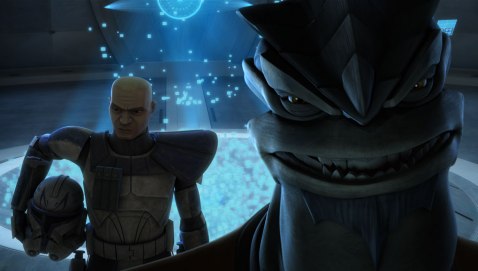Looking Forward and Backward in The Clone Wars
Over the last three weeks on The Clone Wars, we’ve watched the two concluding episodes of the Umbara arc featuring General Krell, Captain Rex, and the 501st, and first episode of the Zygerria arc based on the Slaves of the Republic comic by Season One head writer Henry Gilroy. More than most episodes in the series, these stories have overtly looked forward to the characters’ fates and back into their pasts at the experiences that have shaped them. With all the great action sequences TCW has offered, it’s these deep thematic connections to the characters and their choices that give the series its resonance.
For much of TCW we’ve watched the growing bonds between the Jedi and the clones, yet we know that many of these same clones will ruthlessly carry out Order 66 without hesitation. The conclusion of the Umbara arc reinforces the reality that, despite their intelligence and creativity, the clones are profoundly bound by their duty to obey orders. Only in the most extreme circumstances will they disobey, and Umbara becomes just that sort of test for them.  Rex sanctions the covert operation to attack the supply ship only because Krell’s plan is so absurdly risky to the clones’ lives by comparison. The firing squad refuses to shoot Fives and Jesse only because the order to execute them was so disproportional to their offense and so divergent from expected procedure. And both battalions turn against Krell only after the full horror of his treason is revealed to them. It’s no coincidence that Dogma, the true believer trooper most devoted to following orders, and who feels the greatest pain at the heartless candor of Krell’s betrayal, is the one who fires the shot to execute him. Every one of these scenes was heavy with emotional intensity, and especially the brilliance of Dee Bradley Baker’s acting. So while it may seem hard to imagine that these clones would willingly gun down the Jedi in cold blood, Umbara reminds us that clones disobey only when pushed to their very limits. With Krell’s treachery already on their minds, the word of the failed Jedi assassination attempt on Palpatine and failed overthrow of the Republic – the very thing the clones have been waging three years of war to prevent – could make even the clones who consider Jedi to be friends all too accepting of Order 66 in Revenge of the Sith.
Rex sanctions the covert operation to attack the supply ship only because Krell’s plan is so absurdly risky to the clones’ lives by comparison. The firing squad refuses to shoot Fives and Jesse only because the order to execute them was so disproportional to their offense and so divergent from expected procedure. And both battalions turn against Krell only after the full horror of his treason is revealed to them. It’s no coincidence that Dogma, the true believer trooper most devoted to following orders, and who feels the greatest pain at the heartless candor of Krell’s betrayal, is the one who fires the shot to execute him. Every one of these scenes was heavy with emotional intensity, and especially the brilliance of Dee Bradley Baker’s acting. So while it may seem hard to imagine that these clones would willingly gun down the Jedi in cold blood, Umbara reminds us that clones disobey only when pushed to their very limits. With Krell’s treachery already on their minds, the word of the failed Jedi assassination attempt on Palpatine and failed overthrow of the Republic – the very thing the clones have been waging three years of war to prevent – could make even the clones who consider Jedi to be friends all too accepting of Order 66 in Revenge of the Sith.
On the Forcecast Roundtable a couple of weeks ago, we had fun speculating on who would stop Krell’s mad reign, as did some of the other fansites. Kudos to Pete Morrison of Lightsaber Rattling for hitting it pretty close to the mark. While I thought Obi-Wan would be the one to save the day, Jimmy thought it had to be Anakin who would rescue the clones. One sign of a great story is a twist that reveals the heroic standards that motivate others to heroism. While Anakin didn’t appear in person, of course, his inspiration very much served as the example the clones needed to find the courage to save themselves. The tale of Anakin’s youthful exploits in the Battle of Naboo gave the clones the idea to attack the supply ship and the confidence to believe its destruction could turn the tide of the battle for them, too. More importantly, by treating the troopers under his command like men, Anakin inspired them to act like heroes even in his absence – and it was that moral fortitude that enabled Rex, Fives, and the others to stand up for themselves and stand down a mighty Jedi warrior. This theme of inspiring by heroic example has strong power in the Star Wars saga. In Return of the Jedi, in much the same way, it is Luke’s courage to remain a Jedi despite every test thrown at him by the Emperor that inspires his father to reach within himself and vindicate Padmé’s undying faith that there is still good in Vader.
 In the character of General Krell and his choices on Umbara, we see encapsulated the truly insidious nature of Palpatine’s machinations by creating and prolonging the war. The conflict undermines the very fabric of the Jedi’s moral code, forcing them to constantly make ends-justify-means decisions on the battlefield. Over time, this way of thinking can infect the rest of a Jedi’s thought process – the literal manifestation of the metaphorical poison of the dark side when Son’s creature form bit Ahsoka on Mortis. Add to that the visions Jedi can receive in the Force, as Krell claims to have seen a new order rise from the ashes of the war, and it becomes even easier to justify selfish choices for personal survival rather than selfless sacrifice for the greater good – again an echo of Mortis, where Anakin sides with Son in a desperate attempt to prevent the terrible future he is shown in a vision. Krell’s villainous monologue to the clones makes clear that he has not yet even contacted Count Dooku to form a new alliance; he is simply serving himself. How many other Jedi will succumb to similar bad choices by the time The Clone Wars draws to a close?
In the character of General Krell and his choices on Umbara, we see encapsulated the truly insidious nature of Palpatine’s machinations by creating and prolonging the war. The conflict undermines the very fabric of the Jedi’s moral code, forcing them to constantly make ends-justify-means decisions on the battlefield. Over time, this way of thinking can infect the rest of a Jedi’s thought process – the literal manifestation of the metaphorical poison of the dark side when Son’s creature form bit Ahsoka on Mortis. Add to that the visions Jedi can receive in the Force, as Krell claims to have seen a new order rise from the ashes of the war, and it becomes even easier to justify selfish choices for personal survival rather than selfless sacrifice for the greater good – again an echo of Mortis, where Anakin sides with Son in a desperate attempt to prevent the terrible future he is shown in a vision. Krell’s villainous monologue to the clones makes clear that he has not yet even contacted Count Dooku to form a new alliance; he is simply serving himself. How many other Jedi will succumb to similar bad choices by the time The Clone Wars draws to a close?
As the Zygerria arc begins, the story shifts focus from foreshadowing to the shadows cast on the present by the past. Most prominent, of course, is Anakin’s struggle to deal with raw emotions brought out by confronting slavers. His anger is apparent in his voice and written all over his face.  When he holds the hilt of his lightsaber to D’Nar’s throat, we witness one of the few moments in the series when Ahsoka appears to be genuinely disturbed, if not frightened, by her Master’s intentions. Perhaps her doubt comes in part from the revelation, a short time earlier from Obi-Wan, that Anakin had never mentioned such an important piece of his life to her before. As the Jedi head undercover to seek the missing colonists, Anakin will have to face his emotions even more – just as Ahsoka will come face to face with the harm inflicted on so many Togrutans just like her.
When he holds the hilt of his lightsaber to D’Nar’s throat, we witness one of the few moments in the series when Ahsoka appears to be genuinely disturbed, if not frightened, by her Master’s intentions. Perhaps her doubt comes in part from the revelation, a short time earlier from Obi-Wan, that Anakin had never mentioned such an important piece of his life to her before. As the Jedi head undercover to seek the missing colonists, Anakin will have to face his emotions even more – just as Ahsoka will come face to face with the harm inflicted on so many Togrutans just like her.
Looking ahead to the remaining two episodes in the Zygerria arc, it will be interesting to see how the television series adapts the Slaves of the Republic comic arc to the screen. Dave Filoni recently promised more Obi-Wan to come in Season Four, and this arc may mark the start. Although the A-plot of Slaves of the Republic involves Anakin and Ahsoka undercover, the B-plot gave a significant storyline to Obi-Wan and Rex. In fact, several of Obi-Wan’s scenes, especially those toward the end of the story, are quite emotionally powerful as they flesh out what he believes about himself and the Force he serves. If the adaptation holds true to the source, taking a beating just to stall for time is only the beginning of his Jedi heroism in the Zygerria arc.
Don’t forget to watch “Slaves of the Republic” on Friday, December 2 at 8:00 p.m. Eastern on Cartoon Network.
- Hyperspace Theories: Bad Luck Ghorman - June 2, 2025
- Hyperspace Theories: One Year Later as ANDOR Kicks Off Season Two - May 15, 2025
- REVIEW: Tales of the Underworld - May 4, 2025












Great article! The first slaver episode didn’t impress me but I’m looking forward to tonight’s episode.
Awesome blog, by the way! It’s nice to see other Star Wars fangirls on the web.